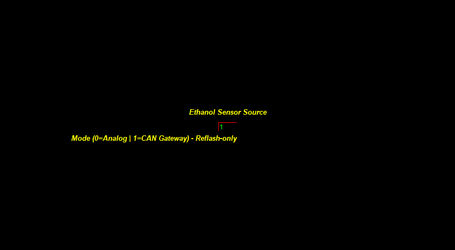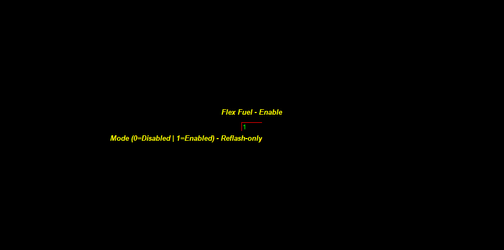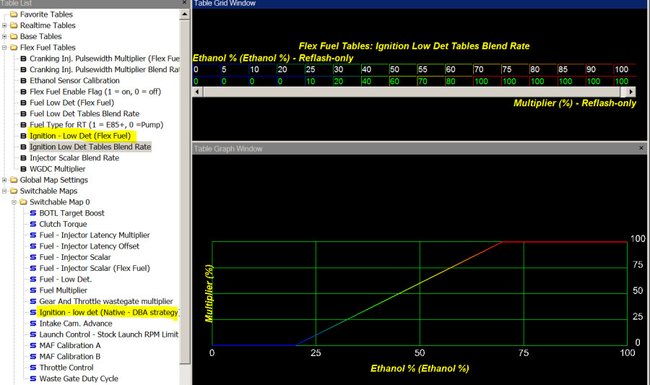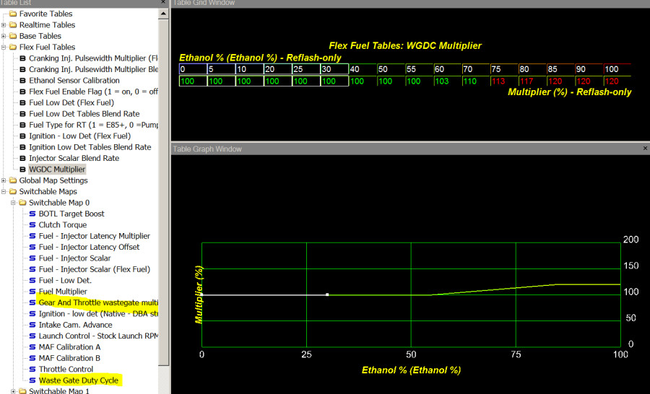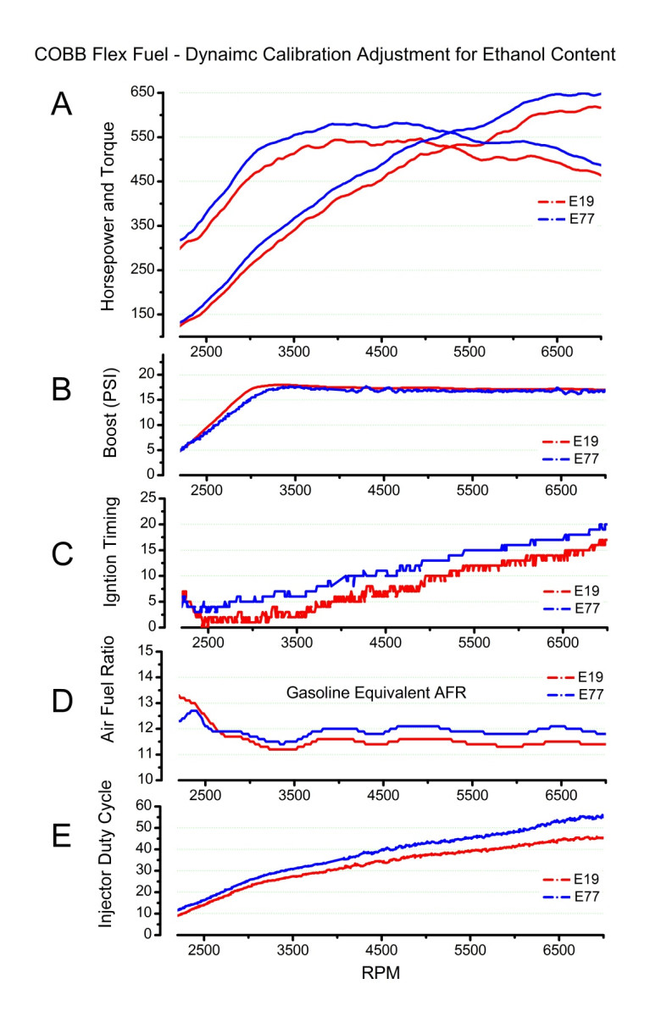GT-R Flex Fuel Tuning Guide
Initial Setup
COBB Flex Fuel (FF) custom code for GT-R is designed to allow the seamless integration of high and low ethanol engine calibrations such that an ideal calibration is produced across the full range of potential ethanol fuel contents. Using this tuning approach, your customers never have to worry about ethanol content. Properly configured and calibrated, a Flex fuel enabled GT-R can run on fuel composed of 0 to 100% ethanol.
- Video tutorial here
The addition of new Flex Fuel capability leaves other GT-R tuning parameters unchanged. All but one tuning table related to flex fuel is contained in the "Flex Fuel" tuning folder and each table is considered "base" table meaning that the ECU must be flashed in order for changes to be saved.
Flex Fuel tables are contained in a separate folder within the base tables. These tables require a flash to load into the ECU.
| Info | ||
|---|---|---|
| ||
Flex Fuel tables are contained in a separate folder within the base tables. These tables require a flash to load into the ECU. |
The basic tuning approach for Flex Fuel allows the calibrator to blend a tune for low ethanol and a tune for high ethanol. In order to accomplish this blending the car must be fully tuned on two fuels with very different ethanol concentrations. The finished product of these two distinct tunes is then combined within the flex fuel tables and the switchable maps.
Step 1) – Tune for fuel one and note the ethanol concentration. Use standard real time tuning tables and store your finished tune within the switchable maps as is customary.
Step 2) – Tune for fuel two and note the ethanol concentration. Use standard real time tuning tables and store your finished tune within the switchable maps as is customary.
Step 3) – Combine the two calibrations in one file.
- At this point you must segregate the two calibrations. The fuel (high or low ethanol) that is most commonly used in the car should be stored in the switchable map slots. Because there are 9 separate map slots within any calibration this will give your final tune the greatest flexibility for the end user.
- Tuning parameters for the secondary fuel are stored in the "flex fuel" base table section.
- Either High or Low ethanol calibration parameters can be stored in the "flex fuel section". Indicate the identity of these tables by selecting " 1 or 0" in the flex fuel table "Fuel for RT". The longer definition for this table is "fuel for real time", or alternatively you can think of this as the primary fuel. The primary fuel calibration parameters reside within the 9 switchable map slots (0-8) and are available within "real time" while connected to a live ECU.
| Info | ||
|---|---|---|
| ||
Chose the location for high and low ethanol tuning parameters
|
Step 4) Calculate injector scalar for 0 and 100 percent ethanol. Using your two known ethanol concentrations along with their paired injector scalar from the two separate high and low ethanol concentrations you can calculate the theoretical scalar for 0 and 100% ethanol. The proportion of these two different injector scalars for the final calibration varies in a linear manner along with ethanol content.
COBB 1000cc injectors on car.
- Tune 1) 10 % ethanol content and final injector scalar of 980
- Tune 2) 77% ethanol content and final injector scalar of 702
Observed Scalar | 980 | 702 | 0 | 100 | Ethanol extremes |
Observed Ethanol content | 10 | 77 | 1021 | 607 | Calculated Scalar |
So the values to put into this Flex Fuel calibration are 1021 for low ethanol and 607 for high ethanol.
This particular GT-R uses high ethanol fuel for most of the time and low ethanol rarely. As a result the "Fuel type for RT" is set to "1".
Injector scalar information is stored within the switchable maps. The fuel injector scalar used as the primary fuel within the switchable maps is "Fuel – Injector Scalar". In this case, because our primary fuel type for RT is high ethanol this injector scalar is fixed at 607. Likewise, since our alternative fuel is low ethanol pump fuel 1021 is set as the "Fuel – Injector Scalar (Flex Fuel)"
| Info | ||
|---|---|---|
| ||
0 and 100 percent ethanol fuel injector scalars are located within each switchable map and "real time" table. |
The math behind the injector scalar is simple and allows the active injector scalar to vary linearly based upon observed ethanol content. For example the active injector scalar at an ethanol concentration of 50% = 50% of e100 injector scalar (303.5) + 50% of e0 injector scalar (510.5) = 814
% ethanol | E100 | E0 | Active injector scalar |
0 | 607 | 1021 | 1021 |
5 | 607 | 1021 | 1000 |
10 | 607 | 1021 | 980 |
20 | 607 | 1021 | 938 |
25 | 607 | 1021 | 918 |
30 | 607 | 1021 | 897 |
40 | 607 | 1021 | 855 |
50 | 607 | 1021 | 814 |
55 | 607 | 1021 | 793 |
60 | 607 | 1021 | 773 |
70 | 607 | 1021 | 731 |
75 | 607 | 1021 | 711 |
80 | 607 | 1021 | 690 |
85 | 607 | 1021 | 669 |
90 | 607 | 1021 | 648 |
100 | 607 | 1021 | 607 |
| Info | ||
|---|---|---|
| ||
All major tuning parameters are determined by a blend of high and low ethanol tables values and weighted according to ethanol concentration. |
Step 5) Set ethanol based blending for each major tuning parameter.
Each of the tables within the "flex fuel" tables is paired with a separate ethanol blending table.
| Info | ||
|---|---|---|
| ||
Final Ignition timing (Fuel target and Cranking Enrichment) are determined by a blend of high and low ethanol tables values and weighted according to ethanol concentration. |
Step 6) - Boost control and Flex fuel. Flex fuel adds a third table that allows the tuner to transform wastegate control based on ethanol content.
Flex fuel code maintains the 9 separate potential user selectable boost levels contained within the switchable map slots. Some tuners will choose to allow the end user to select boost irrespective of ethanol concentration. However, others will additionally choose to use the ethanol based wastegate duty cycle multiplier to offset boost based on ethanol content.
Final wastegate duty cycle = (Waste Gate Duty Cycle)(Gear and throttle wastegate Multiplier)(Flex Fuel WGDC multiplier)
| Info | ||
|---|---|---|
| ||
Boost control and ethanol Content. A separate wastegate duty cycle multiplier map in the "Flex Fuel" tables allows boost control by ethanol content. |
Table Descriptions and tuning tips – Flex Fuel Tables
- Cranking Pulse width multiplier - is used to adjust cranking fuel as a function of coolant temperature. This table is paired with the fuel type that is located in the flex fuel folder.
- Cranking Inj. Pulsewidth Multiplier Blend Rate – this table determines the proportion of the "Flex Fuel – Cranking Pulse Width Multiplier" and the non-flex fuel "Cranking Pulse width multiplier" is used as a function of ethanol content.
- Ethanol Sensor Calibration – 0 to 5V calibration of the ethanol sensor output. Note – ethanol sensors use frequency to report ethanol content and this frequency must be translated to a 0 to 5V signal with additional hardware.
- Flex Fuel enable Flag – enable or disable Flex fuel code with a 1 or 0 here.
- Fuel Low Det (Flex Fuel) – Fuel target table identical to the standard fuel target with axis defined by Load and engine RPM. This table indicates fuel targets used for the fuel type located in the "flex fuel" folder.
- Fuel Low Det Blend Rate – this table determines the weighted mix of "flex fuel" and "switchable Map" Low Det Fuel targets as a function of ethanol content.
- Ignition Low Det (Flex Fuel) – Ignition timing table identical to the standard ignition timing table with axis defined by Load and engine RPM. This table indicates ignition timing used for the fuel type located in the "flex fuel" folder.
- Ignition Low Det Tables Blend Rate – this table determines the weighted mix of "flex fuel" and "switchable Map" ignition timing as a function of ethanol content.
- Injector scalar Blend Rate – This table determines the proportion of "Injector Scalar Flex Fuel" and "Injector Scalar" used for the active injector scalar as a function of ethanol content. Tune with two known ethanol contents and injector scalars and calculate E0 and E100 injector scalars for most effective use of flex fuel programming
- WGDC Multiplier – this 1D map acts as a multiplier to final wastegate duty cycle as a function of ethanol content. A value of 100 leaves final wastegate unchanged. A value of 150 increases final duty cycle by 50%. Use this table to increase or decrease boost as a function of ethanol content.
The finished COBB Flex Fuel GT-R Calibration:
COBB Flex Fuel programming and proper calibration ensures optimal and engine power at a full range of ethanol concentrations without the inconvenience of actively switching fuels. Full ethanol dependence of timing, fuel target, injector scaling, and boost control creates a final calibration that elegantly responds and adapts to ethanol changes. The only opaque discernment of any response to increased ethanol content is simply increased power.
| Info | ||
|---|---|---|
| ||
COBB Flex Fuel – Dynamic Calibration Adjustment for Ethanol Content |


